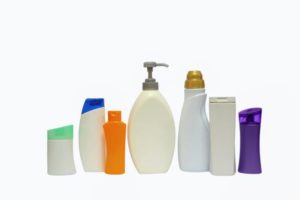The controversy over the safety of BPA (bisphenol A) is still dragging on. However, the new alternatives to BPA may not be any better and may be even worse. To minimize exposure to BPA and other estrogenic chemicals, try to buy and store food in glass bottles, jars, and containers (glass does not contain plastics of any sort). The following two articles discuss this issue. From Nature:
Toxicology: The plastics puzzle
A stroll down the aisles of a US supermarket reveals a modest victory for consumer activism. In the baby-products section, plastic baby bottles, spill-proof cups and miniature cutlery are proudly marked 'BPA-free' — a sign that they no longer contain the compound bisphenol A, found in many plastics.
The partial withdrawal of BPA is the culmination of two decades of research and hundreds of studies linking the compound — which mimics sex hormones called oestrogens — to adverse health effects in rodents and humans. The decision by regulators in the United States and European Union to ban BPA from baby bottles, combined with industry marketing campaigns, has convinced many consumers that the plastics and other containers currently used to store food are safe.
It is a false sense of security. BPA is still a constituent of many food containers, especially cans. And when companies did abandon BPA, they often adopted compounds — such as the increasingly common bisphenol S (BPS) — that share much of the same chemistry and raise many of the same concerns as BPA. “People use this chemical to replace BPA without sufficient toxicological information,” says Kyungho Choi, an environmental toxicologist at Seoul National University. “That is a problem.”
BPA has formed the chemical backbone of most hard, clear polycarbonate plastic since the 1950s. Over time, studies have linked the chemical — which can leach out of plastics and into food — to a host of adverse health effects, including reductions in fertility and birth weight, male genital abnormalities, altered behavioural development, diabetes, heart disease and obesity1 (see Nature464, 1122–1124; 2010).
A few years ago, mounting evidence and concerned consumers convinced governments to take action. In 2011, the European Union banned BPA from baby bottles; the United States followed suit a year later. But BPA-based linings are still slathered on the insides of most food and beverage cans, and used to coat water-supply pipes in many countries. The compound is also found in dental sealants and in incubators for premature infants.
BPA-based epoxy linings are widely used because they are strong, flexible and cheap. They tolerate the high temperatures needed to sterilize foods during canning, and do not interact with a huge array of foods and beverages, according to the North American Metal Packaging Alliance in Washington DC. The alliance estimates that 95% of all aluminium and steel can coatings are epoxy-type resins: more than 99.9% of these contain BPA.
New options are beginning to surface. BPS was first made in 1869 as a dye. But because it was introduced into consumer goods only recently — into cash-register receipts in 2006, for example — few researchers have studied its toxicity. “The main question, to which we have no answer, is: 'is BPS as toxic as BPA?'” says René Habert, an endocrinologist at Paris Diderot University.
The similarity of BPS's structure to that of BPA is enough to raise suspicions that it may mimic oestrogens, says Cheryl Watson, a biochemist at the University of Texas Medical Branch in Galveston. When combined with levels of oestradiol found in adult women, BPS seemed to over-stimulate the pathway, shutting it down and causing cell suicide. The results, says Watson, were typical of those expected of an oestrogen mimic: inappropriate activation of oestrogen responses, disruption of normal oestrogen-response pathways, and eventual cell death.
Some manufacturers have left the bisphenol family in search of a replacement. In 2007, the Eastman Chemical Company launched Tritan — a new heat-resistant clear plastic — for infant-care products such as baby bottles. This BPA-free plastic has since replaced the old BPA-containing polycarbonate in many water bottles, food containers and children's cups.
In 2011, George Bittner, a neurobiologist at the University of Texas at Austin and the chief executive of Austin-based chemical-testing company CertiChem, reported that 92% of 102 commercially available plastic products leached chemicals with oestrogenic activity7. This included plastics advertised as BPA-free. The reason, Bittner says, is that additives in plastics — such as stabilizers and lubricants — can also bind to oestrogen receptors, as can some of the plastic monomers themselves. Tritan resins produced by Eastman were among the polymers that showed oestrogenic activity in Bittner's assays.
In 2012, the world produced some 280 million tonnes of plastic. According to a model based on the United Nations' Globally Harmonized System of Classification and Labelling of Chemicals, more than 50% of these plastics contain ingredients that can be hazardous (see Nature 494, 169–171; 2013). Some are carcinogenic; others are oestrogenic.
It is not yet clear how many of these chemicals are dangerous at the concentrations found in the plastics. But mixed together, the chemicals could have synergistic effects.
Ideally, says Watson, the next generation of chemicals would be tested for effects on oestrogen signalling before widespread deployment in food containers.
From Mother Jones:
The Scary New Evidence on BPA-Free Plastics
 Think that BPA-free products are safe? Oops... it doesn't look like it. The most common replacement for the commonly used chemical compound BPA (bisphenol A) is BPS (bisphenol S). But it has become very clear that both are hormone disrupting chemicals with numerous and harmful health effects, especially reproductive disorders.
Think that BPA-free products are safe? Oops... it doesn't look like it. The most common replacement for the commonly used chemical compound BPA (bisphenol A) is BPS (bisphenol S). But it has become very clear that both are hormone disrupting chemicals with numerous and harmful health effects, especially reproductive disorders.
 The research finding of
The research finding of